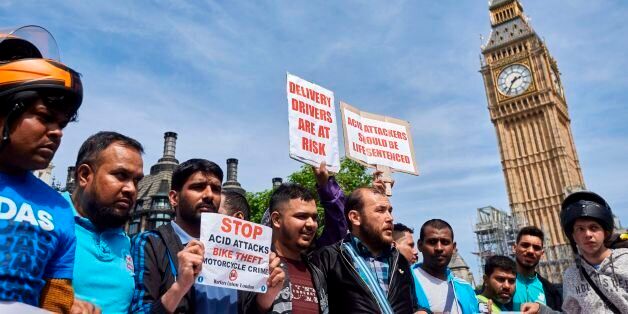
The very fact that MPs have been called to debate acid attacks reveals that the authorities have been caught on the hop by the rise of this violent and horrific crime.
East London, in particular, has seen a huge increase in acid attacks, including the recent life-changing acid attacks Resham Khan and Jameel Mukhtar, which have been classified as a hate crime.
The spate of recent acid attacks has raised fears within Muslim communities over whether they are racially or religiously motivated.
The reality is a more complex picture. Acid crime is used in robbery, gender-based violence, hate crime, and sometimes in random assaults.
A Freedom of Information request to the Metropolitan Police in March revealed that acid attacks had doubled since 2012, but the increase has been particularly acute in areas such as Newham with 398 incidents between 2011 and 2016; Barking and Dagenham with 134 and Tower Hamlets with 84.
Understanding the rise in acid attacks is not straight forward. Internationally the majority of acid attacks are perceived as gender-based violence where, usually, a man has been spurned by a woman in love, marriage or a sex proposal, but in the UK a high proportion of attacks appear to be amongst males between gangs or robbery-related rather than racially or religiously-motivated hate crime.
The announcement by the Home Secretary, Amber Rudd, that the government will undertake a "wide-ranging review" to assess how we can combat acid attacks is timely, but it is important to balance 'quick-fix solutions' which may reassure the wider public with measures that have been proven to be effective with reducing this type of crime.
This means that the government needs to be cautious when it says it will consider "tougher sentences on perpetrators" as this is unlikely to be effective in preventing acid attacks.
This is partly because punishment for this type of crime is already quite severe as it can result in a conviction for assault or a more serious charge of grievous bodily harm (GBH), which can carry a maximum life-sentence. There is also a 'lesser' charge for 'carrying an offensive weapon' which can result in 4 years in prison although the authorities need to prove 'intent to harm'.
More importantly, research has shown that there is a weak link between the severity of punishments and crime rates, with researchers concluding that passing harsher sentences does not "enhance the deterrence effect". Of course, it may be that perpetrators carrying and using acid as a weapon are not aware of the current legal consequences of their actions, or perhaps they are assuming that their victims will not report the attack for fear of reprisals.
But this suggests increasing awareness of the law starting at an early age, inside and outside of school, rather than strengthening it.
It is clear, however, that we need to restrict the supply of corrosive-liquids as currently it can be purchased cheaply and easily from most hardware/ DIY stores or online without a basic check. This is clearly a loophole given that anyone, including younger people under the age of 18, can purchase corrosive liquids which is easy to conceal and which can be used as a weapon to cause maximum harm.
There is, therefore a strong argument for licensing the purchase of corrosive and harmful liquids and for reviewing other effective ways of limiting access to acid-based chemicals. For example, purchase with credit or debit cards can be linked back to a name and address.
But we are still left with real concerns about public safety and drop in confidence among ethnic minority communities in London in relation to acid attacks. The reality is these attacks, whether involving gangs or robbery-related, are also happening in areas with high proportions of ethnic minority communities which means that ethnic minority and/or Muslim communities' perceptions of an increased threat to their safety is not misplaced, even though the attribution of the motivation may be.
One possible solution raised by the Home Secretary is to increase stop and search, but given the controversy with this approach in relation to knife crime in terms of exacerbating community relations with black communities this policing strategy could backfire.
Another policing solution, however, which could have multiple benefits, is to increase community police support officers on the ground, which has been shown to have a positive impact on community relations and confidence-building and may even help to prevent or reduce acid attacks based on local intelligence.
Dr Zubaida Haque is a research associate at the Runnymede Trust. She tweets at @zubhaque